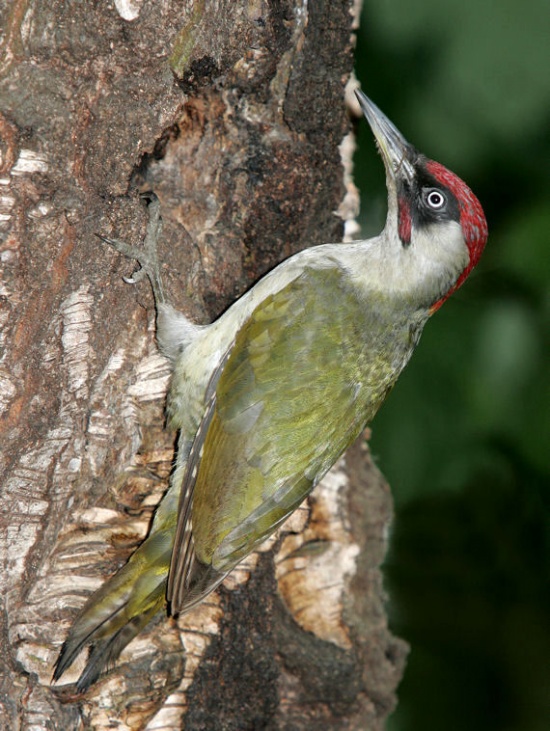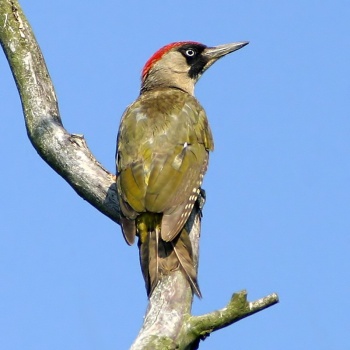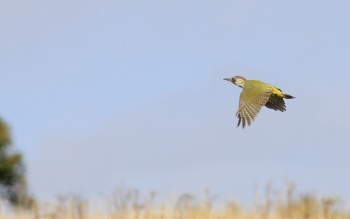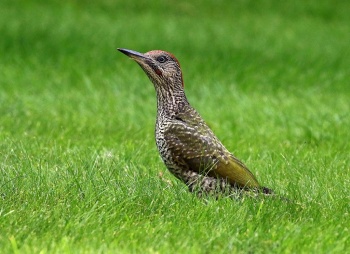Sbarnhardt (talk | contribs) (Add Category Videos) |
|||
| (9 intermediate revisions by 4 users not shown) | |||
| Line 1: | Line 1: | ||
| − | [[Image:Green_Woodpecker2.jpg|thumb| | + | [[Image:Green_Woodpecker2.jpg|thumb|550px|right|Male<br />Photo © by {{user|NIGHTJAR1|NIGHTJAR1}}<br />[[Nottinghamshire]], [[UK]], June 2006]] |
;[[:Category:Picus|Picus]] viridis | ;[[:Category:Picus|Picus]] viridis | ||
| − | |||
==Identification== | ==Identification== | ||
31–33 cm (12¼-13 in) | 31–33 cm (12¼-13 in) | ||
| Line 13: | Line 12: | ||
Sexes similar except male has a crimson centre to the moustache<br /> | Sexes similar except male has a crimson centre to the moustache<br /> | ||
'''Juvenile''': duller and has whitish barred underparts | '''Juvenile''': duller and has whitish barred underparts | ||
| − | |||
====Similar Species==== | ====Similar Species==== | ||
[[Levaillant's Woodpecker]], [[Grey-headed Woodpecker]] | [[Levaillant's Woodpecker]], [[Grey-headed Woodpecker]] | ||
==Distribution== | ==Distribution== | ||
| − | Generally common and widespread over much of its range; scarce, but increasing, on the northern fringes of its range. Breeds in [[Britain]] north to central [[Scotland]], and from [[France]] east to about 50 degrees east in [[Russia]], also in the [[Caucasus]], [[Iran]] and southwesternmost [[Turkmenistan]]. In the north found in coastal and southern parts of [[Norway]] and [[Sweden]], [[Poland]] and the [[Baltic States]]. Occurs south to the north Mediterranean coast from southern [[ | + | [[Image:Eurasian_Green_Woodpecker.jpg|thumb|350px|right|Female<br />Photo © by {{user|Sandpiper|Sandpiper}}<br />Colwick, [[Nottinghamshire]], [[UK]], 4 August 2003]] |
| + | Generally common and widespread over much of its range; scarce, but increasing, on the northern fringes of its range. Breeds in [[Britain]] north to central [[Scotland]], and from [[France]] east to about 50 degrees east in [[Russia]], also in the [[Caucasus]], [[Iran]] and southwesternmost [[Turkmenistan]]. In the north found in coastal and southern parts of [[Norway]] and [[Sweden]], [[Poland]] and the [[Baltic States]]. Occurs south to the north Mediterranean coast from southern [[France]] to [[Greece]] and [[Turkey (country)|Turkey]]. | ||
Resident throughout range with only short-distance dispersal but may move further in the east as a result of more severe winter weather. | Resident throughout range with only short-distance dispersal but may move further in the east as a result of more severe winter weather. | ||
| Line 25: | Line 24: | ||
==Taxonomy== | ==Taxonomy== | ||
The former Iberian race ''P. v. sharpei'' which lacks the black mask and moustache is now accepted as full species: [[Iberian Green Woodpecker]]<sup>[[#References|[1]]][[#References|[2]]]</sup> | The former Iberian race ''P. v. sharpei'' which lacks the black mask and moustache is now accepted as full species: [[Iberian Green Woodpecker]]<sup>[[#References|[1]]][[#References|[2]]]</sup> | ||
| − | |||
====Subspecies==== | ====Subspecies==== | ||
| + | [[Image:MGL7741 1-bf.jpg|thumb|350px|right|Female<br />Photo © by the late '''[https://www.birdforum.net/gallery/showgallery.php/ppuser/50827/cat/500 Mahsleb]'''<br />[[Minsmere]], [[Suffolk]], 9 October 2012]] | ||
There are three subspecies<sup>[[#References|[1]]]</sup> | There are three subspecies<sup>[[#References|[1]]]</sup> | ||
*''P. v. viridis'': | *''P. v. viridis'': | ||
| Line 40: | Line 39: | ||
Deciduous or mixed woodland, generally in more lowland areas than Grey-headed Woodpecker. Can be common in parks and large gardens, and also open areas with scattered trees, especially in winter. | Deciduous or mixed woodland, generally in more lowland areas than Grey-headed Woodpecker. Can be common in parks and large gardens, and also open areas with scattered trees, especially in winter. | ||
==Behaviour== | ==Behaviour== | ||
| − | + | ||
Usually solitary or in pairs, feeds mainly on the ground, often 'star-gazes'. | Usually solitary or in pairs, feeds mainly on the ground, often 'star-gazes'. | ||
====Flight==== | ====Flight==== | ||
Markedly undulating flight, caused by prolonged closure of wings. | Markedly undulating flight, caused by prolonged closure of wings. | ||
====Breeding==== | ====Breeding==== | ||
| + | [[Image:1-S64A6983.JPG|thumb|350px|right|Juvenile<br />Photo © by {{user|max1|max1}}<br />[[Surrey]], [[England]], 10 August 2016]] | ||
They drill out holes in dead or rotten trees for the nest. The clutch consists of 4-7 glossy white eggs, which are rounded at both ends. | They drill out holes in dead or rotten trees for the nest. The clutch consists of 4-7 glossy white eggs, which are rounded at both ends. | ||
====Diet==== | ====Diet==== | ||
| − | |||
Insects, primarily ants, which are captured by a rapid outward flick of the long tongue, gummed to its tip by sticky saliva. Birds from this species can often be seen searching for and eating ants on the ground (a behaviour shared by several other woodpeckers, including [[:Category:Picus|other green woodpeckers]], [[:Category:Jynx|wrynecks]], and [[:Category:Colaptes|flickers]]). | Insects, primarily ants, which are captured by a rapid outward flick of the long tongue, gummed to its tip by sticky saliva. Birds from this species can often be seen searching for and eating ants on the ground (a behaviour shared by several other woodpeckers, including [[:Category:Picus|other green woodpeckers]], [[:Category:Jynx|wrynecks]], and [[:Category:Colaptes|flickers]]). | ||
====Vocalisation==== | ====Vocalisation==== | ||
'''Call''': A loud ''plue, plue, plue'', which sounds like a laugh, or "yaffle", from which it gets the country name. The alarm call is a truncated variant of the advertising call. | '''Call''': A loud ''plue, plue, plue'', which sounds like a laugh, or "yaffle", from which it gets the country name. The alarm call is a truncated variant of the advertising call. | ||
| − | + | {{ Audio|Picus viridis (song).mp3 }} | |
| − | + | ||
==References== | ==References== | ||
| Line 63: | Line 62: | ||
==External Links== | ==External Links== | ||
| − | {{GSearch|Picus | + | {{GSearch|"Picus viridis" {{!}} "Green Woodpecker"}} |
<br /> | <br /> | ||
| − | {{ | + | {{VSearch|"Picus viridis" {{!}} "Green Woodpecker"}} |
| − | [[Category:Birds]] [[Category:Picus]][[Category:Bird Songs]][[Category:Videos]] | + | {{GS-checked}} |
| + | <br /> | ||
| + | <br /> | ||
| + | |||
| + | [[Category:Birds]] [[Category:Picus]][[Category:Bird Songs]] [[Category:Videos]] | ||
Latest revision as of 12:20, 15 April 2023
- Picus viridis
Identification
31–33 cm (12¼-13 in)
- Dark green upper parts
- Yellowish-green under parts
- Red crown and nape
- Black face mask and moustachial stripe
- Yellow rump
- Black and white outer primaries
- Grey bill and feet
Sexes similar except male has a crimson centre to the moustache
Juvenile: duller and has whitish barred underparts
Similar Species
Levaillant's Woodpecker, Grey-headed Woodpecker
Distribution
Generally common and widespread over much of its range; scarce, but increasing, on the northern fringes of its range. Breeds in Britain north to central Scotland, and from France east to about 50 degrees east in Russia, also in the Caucasus, Iran and southwesternmost Turkmenistan. In the north found in coastal and southern parts of Norway and Sweden, Poland and the Baltic States. Occurs south to the north Mediterranean coast from southern France to Greece and Turkey.
Resident throughout range with only short-distance dispersal but may move further in the east as a result of more severe winter weather. Vagrants have been recorded in Ireland, Finland, Malta and the Balearics.
Taxonomy
The former Iberian race P. v. sharpei which lacks the black mask and moustache is now accepted as full species: Iberian Green Woodpecker[1][2]
Subspecies
There are three subspecies[1]
- P. v. viridis:
- P. v. karelini: duller and greyer than the nominate
- Southeastern Europe to Asia Minor, northern Iran and southwestern Turkmenistan.
- P. v. innominatus:
- Zagros Mountains (Southwestern Iran).
A further population described from southeast Iran as P. v. bampurensis is of uncertain status, and may be extinct.[3]
Habitat
Deciduous or mixed woodland, generally in more lowland areas than Grey-headed Woodpecker. Can be common in parks and large gardens, and also open areas with scattered trees, especially in winter.
Behaviour
Usually solitary or in pairs, feeds mainly on the ground, often 'star-gazes'.
Flight
Markedly undulating flight, caused by prolonged closure of wings.
Breeding
They drill out holes in dead or rotten trees for the nest. The clutch consists of 4-7 glossy white eggs, which are rounded at both ends.
Diet
Insects, primarily ants, which are captured by a rapid outward flick of the long tongue, gummed to its tip by sticky saliva. Birds from this species can often be seen searching for and eating ants on the ground (a behaviour shared by several other woodpeckers, including other green woodpeckers, wrynecks, and flickers).
Vocalisation
Call: A loud plue, plue, plue, which sounds like a laugh, or "yaffle", from which it gets the country name. The alarm call is a truncated variant of the advertising call.
References
- Clements, J. F., T. S. Schulenberg, M. J. Iliff, S. M. Billerman, T. A. Fredericks, B. L. Sullivan, and C. L. Wood. 2019. The eBird/Clements Checklist of Birds of the World: v2019. Downloaded from http://www.birds.cornell.edu/clementschecklist/download/
- Gill F, D Donsker & P Rasmussen (Eds). 2020. IOC World Bird List (v10.1). doi : 10.14344/IOC.ML.10.1. Available at http://www.worldbirdnames.org/
- Del Hoyo, J, A Elliot, and J Sargatal, eds. 2002. Handbook of the Birds of the World. Volume 7: Jacamars to Woodpeckers. Barcelona: Lynx Edicions. ISBN 978-8487334375
- Avibase
- Peterson, RT, G Mountfort and PAD Hollom. 1993. Collins Field Guide – Birds of Britain and Europe, 5th Revised edition. London: HarperCollins Publishers. ISBN 978-0002199001
- AvianWeb
- Swain, H.D. (1985) The Observer's Book of Birds' Eggs, Frederick Warne. ISBN 0723200602
- Winkler, H. and D.A. Christie (2020). Eurasian Green Woodpecker (Picus viridis), version 1.0. In Birds of the World (J. del Hoyo, A. Elliott, J. Sargatal, D.A. Christie, and E. de Juana, Editors). Cornell Lab of Ornithology, Ithaca, NY, USA. https://doi.org/10.2173/bow.eugwoo2.01
Recommended Citation
- BirdForum Opus contributors. (2024) Eurasian Green Woodpecker. In: BirdForum, the forum for wild birds and birding. Retrieved 28 April 2024 from https://www.birdforum.net/opus/Eurasian_Green_Woodpecker
External Links
GSearch checked for 2020 platform.







